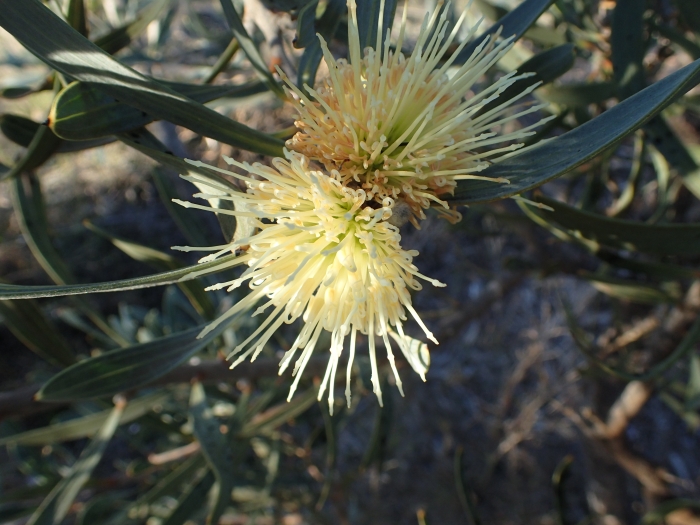Ashy Hakea
(Hakea cinerea)
Ashy Hakea (Hakea cinerea)
/
/

Geoff Derrin
CC BY-SA 4.0
Image By:
Geoff Derrin
Recorded By:
Copyright:
CC BY-SA 4.0
Copyright Notice:
Photo by: Geoff Derrin | License Type: CC BY-SA 4.0 | License URL: https://creativecommons.org/licenses/by-sa/4.0 | Uploader: Gderrin | Publisher: Wikimedia Commons | Title: Hakea_cinerea_flowers.jpg | Notes: Transferred from Flickr via [[Commons:Flickr2Commons|Flickr2Commons]] |



















Estimated Native Range
Summary
Hakea cinerea, commonly known as Ashy Hakea, is an evergreen shrub native to the sandy plains, open woodlands, and coastal scrublands of Western Australia. It is a non-lignotuberous species, meaning it does not have a swollen base or root system that can resprout after fire. This rounded shrub typically grows to a height of 0.7 to 2.5 meters (2.3 to 8.2 ft) with ascending branches and is noted for its contrasting ash-colored grey-green leaves. The inflorescence consists of 40-56 large, showy creamy-white and yellow flowers that turn orange with age. These flowers are clustered in the leaf axils and bloom from late winter to early summer (August to November in the Southern Hemisphere), attracting pollinators such as birds and insects.
Ashy Hakea is valued for its ornamental features, including its unique foliage and colorful flowers. It serves well as a windbreak or for providing wildlife habitat, and its dense growth habit can be utilized for screening purposes in gardens. This shrub is drought-tolerant once established, making it suitable for xeriscaping and low-water-use gardens. It thrives in full sun and requires soils with good drainage, ranging from sandy to loamy textures. While it is generally low-maintenance, it can be susceptible to root rot if overwatered or planted in poorly drained soils. Gardeners should be aware that Hakea species can become invasive when grown outside their native range and should be planted with caution.CC BY-SA 4.0
Ashy Hakea is valued for its ornamental features, including its unique foliage and colorful flowers. It serves well as a windbreak or for providing wildlife habitat, and its dense growth habit can be utilized for screening purposes in gardens. This shrub is drought-tolerant once established, making it suitable for xeriscaping and low-water-use gardens. It thrives in full sun and requires soils with good drainage, ranging from sandy to loamy textures. While it is generally low-maintenance, it can be susceptible to root rot if overwatered or planted in poorly drained soils. Gardeners should be aware that Hakea species can become invasive when grown outside their native range and should be planted with caution.CC BY-SA 4.0
Plant Description
- Plant Type: Shrub
- Height: 4-6 feet
- Width: 6-8 feet
- Growth Rate: Moderate
- Flower Color: Yellow, Orange
- Flowering Season: Spring
- Leaf Retention: Evergreen
Growth Requirements
- Sun: Full Sun
- Water: Low, Medium
- Drainage: Medium, Fast
Common Uses
Drought Tolerant, Low Maintenance, Showy Flowers
Natural Habitat
Native to sandy plains, open woodlands, and coastal scrublands of Western Australia
Other Names
Common Names: Grey Hakea
Scientific Names: , Hakea cinerea, Hakea canescens, Hakea tricostata,
GBIF Accepted Name: Hakea cinerea R.Br.